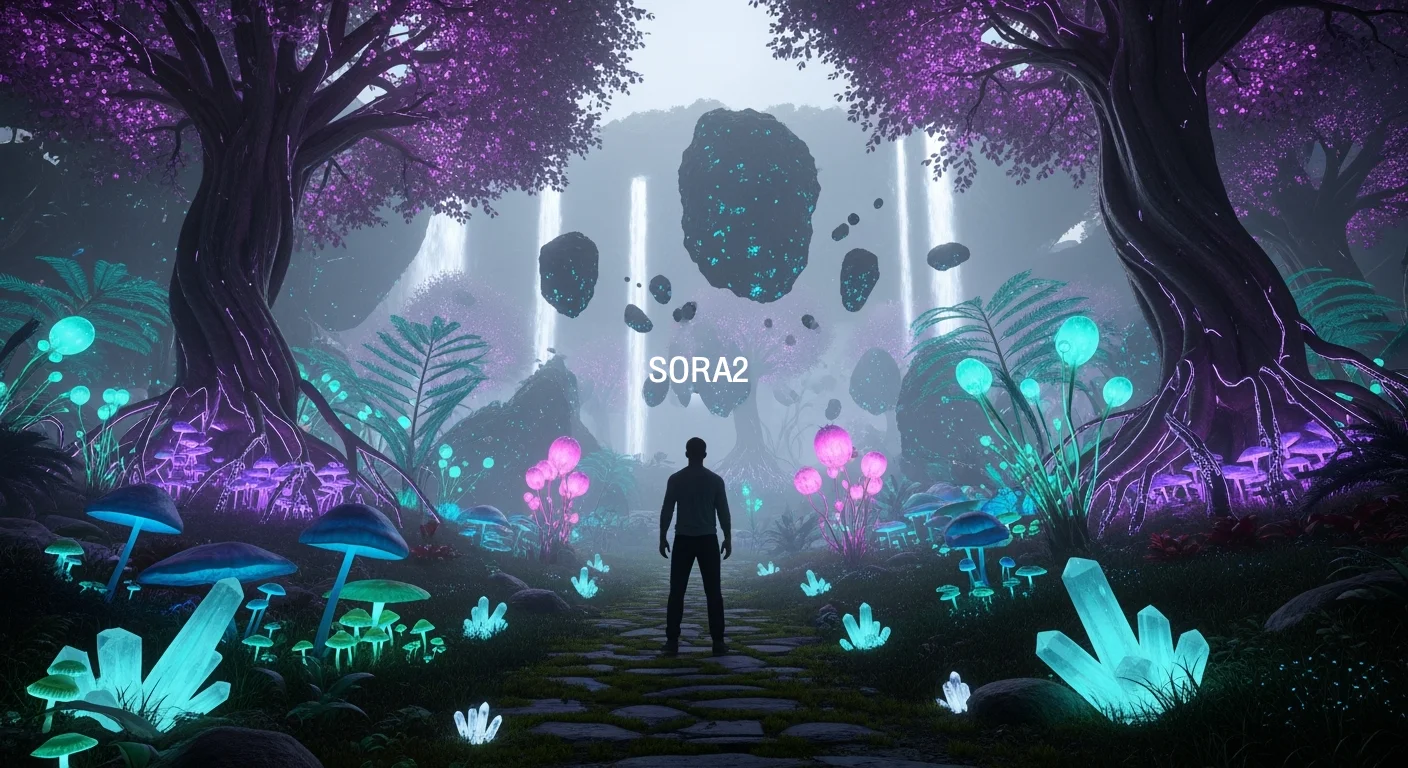Sora 2 is the latest version of OpenAI’s text-to-video and audio generation system, rolled out publicly (with app support) in late September 2025. OpenAI+2OpenAI+2 It builds on the original Sora model, but with important enhancements in realism, controllability, and expressiveness. OpenAI+2OpenAI+2
Key technical & design improvements
Some of the improvements Sora 2 brings include:
-
More physically accurate motion dynamics (e.g. better simulation of movement, gravity, interactions) OpenAI+2OpenAI+2
-
Sharper visual fidelity, improved rendering of detail, lighting, textures OpenAI+2OpenAI+2
-
Synchronized audio, lip-sync, sound effects — making generated videos more cohesive as audiovisual artifacts rather than just stitched frames + generic audio OpenAI+2OpenAI+2
-
Enhanced steerability / control — users get more levers to constrain or guide how their avatars or “cameos” appear (e.g. restricting political content, language, or style) The Verge+2OpenAI+2
-
An expanded stylistic range: you can push the model into more cinematic, stylized, or expressive modes rather than only photorealism OpenAI+1
-
A built-in social-app component: Sora 2 is not just a model, but shipped with an app for sharing, feed-based discovery, remixing, and publication. Puck+3WIRED+3OpenAI+3
-
Watermarking and metadata: by default, videos incorporate a visible watermark and metadata tags to flag that they are AI-generated. Wikipedia+2OpenAI+2
Thus, Sora 2 is not just a laboratory model, but a full-stack content creation + social distribution platform — a fusion of AI generation and social media in one.
The Social Media & Content Implications
The arrival of Sora 2 carries deep implications for how media is produced, shared, and perceived. Below are key dimensions to watch.
1. Democratization of video creation — faster, lower barrier
One of the most immediate impacts is that the cost and friction of producing “cinematic” or expressive video content drops dramatically. Creators (including amateur ones) can generate compelling visuals and narratives without cameras, sets, or large budgets. Sora 2’s ease and control means that video becomes more like text or image — something many people can wield.
This shift could accelerate a wave of user-generated content (UGC) that is far more polished, imaginative, and experimental. Social media platforms may thus see a new class of creators who compete not just by editing or filming, but by prompt-engineering, remixing, and iteration.
However: the flip side is that the new digital arms race intensifies. To stand out, creators will need not just skill, but savvy prompt design, curation, and brand identity. The barrier shifts from “who has the gear” to “who has the ideas (and prompt mastery).”
2. The authenticity & truth problem — seeing is no longer believing
Perhaps the most profound risk is the erosion of trust in visual media. Historically, videos have had a special authority: we assume video is harder to fake, harder to manipulate than text. Sora 2 threatens that assumption. Realistic deepfake videos — including of public figures, composite scenarios, manipulated events — can now be produced and disseminated widely. Puck+4The Guardian+4The Washington Post+4
Indeed, critics report that violent, racist, or misleading content has already begun appearing despite guardrails. The Guardian+2WIRED+2 The capability to insert one’s likeness (or someone else’s) into a video (“cameos”) adds a further twist: your face or voice can appear in unexpected or manipulated contexts. The Washington Post+3The Verge+3Sam Altman+3
In the social media ecosystem, this degrades the “trusted signal” of video. Platforms, users, fact-checkers, news media — all will have to grapple with whether a video is real, AI-generated, or stitched together.
3. Platform dynamics & algorithmic amplification
Because Sora 2 is built with a feed-based, swipe UI akin to TikTok (vertical video, recommendation-driven “For You” style feed), it brings AI-generated content into the same engagement-driven mechanics that fuel modern social media. OpenAI+3WIRED+3Puck+3
That means:
-
The same incentives (virality, short attention span, shock & novelty) will push creators toward provocative, catchy, remixable content.
-
Algorithms may favor AI-generated content that maximizes engagement (e.g. sensational, eye-catching), even if it is shallow or harmful.
-
The boundary between original and derivative content blurs — remixing and “inspired by” become the norm.
-
Incumbent platforms may feel pressure: will TikTok, Instagram Reels, YouTube Shorts, etc., begin integrating generative AI features, or clamp down on AI-generated content? We already see Meta pushing its own tools (e.g. Vibes) and YouTube’s Veo model competition. WIRED+2Puck+2
OpenAI, by bundling generation + social feed, places itself not just as a model provider but as a content platform — and potentially a competitor to existing giants.
4. Copyright, IP, and creative ownership battles
One of the most contentious issues is how Sora 2 handles copyrighted material. By default, Sora 2 allows incorporation of copyrighted characters or settings unless the rights holder actively opts out. Vox+4Wikipedia+4OpenAI+4 That means fans can generate videos using iconic characters or scenes, potentially infringing on IP. Critics argue this shifts the burden onto studios to police and opt out. Artificial Corner+3Vox+3Puck+3
This could trigger waves of legal challenges: studios, creators, artists may push for licensing, takedowns, or stricter controls. It also raises questions of attribution, revenue sharing, and moral rights.
Furthermore, even for original creations, the “derivative vs generative” line is fuzzy. How much ownership does a prompt-based video deserve? What counts as originality when a model used training from vast copyrighted corpora?
5. Psychological, social, and cultural effects
The ease of creating immersive, emotionally rich video content means that social media may become more immersive, more synthetic, more emotionally intense. But it also risks greater superficiality, reflexive consumption, and aesthetic homogenization (if many people are remixing the same styles).
The addictive nature of scrolling through short, high-fidelity clips is enhanced when each clip is not just human-shot but artistically surprising. Critics already draw parallels to “AI slop” — too much of this viral remix content may degrade attention spans, shallow engagement, and shock-based content proliferation. Vox+2OpenAI+2
Social dynamics may shift: authenticity (voice, lived experience) could become a premium signal, as audiences crave something “real” amid the synthetic flood. Identity, persona, and digital reputation take on new stakes when even your face/voice can be remixed.
Risks & Challenges
While the upside is vast, the risks are equally significant. Some of the leading concerns include:
-
Misinformation, political manipulation, and disinformation campaigns. Realistic AI video is a powerful tool for deception. A fabricated video of a political figure making false claims could spread widely before detection.
-
Harassment, impersonation, and defamation. People may create videos putting others in false, embarrassing, or defamatory contexts. The control mechanisms (e.g. blocking one’s likeness) may not suffice. The Verge+2The Washington Post+2
-
Deepfake of deceased or public figures. Already videos have surfaced showing deceased icons in fictional interactions. Such misuse provokes ethical, emotional, and legal backlash. Indiatimes+1
-
Guardrail failures and content moderation rollback. Early reports suggest that violent or hateful content slipped through the moderation filters soon after launch. The Guardian+1
-
IP conflicts and legal liabilities. As discussed, the default permissiveness toward copyrighted elements invites disputes, takedown demands, litigation.
-
Bias, fairness, and representation. As with many generative models, biases in training data may result in stereotyped or skewed portrayals. A study of the original Sora found gender biases in its outputs. arXiv
-
Ecosystem centralization and power concentration. Because Sora 2 is controlled by OpenAI, the platform and algorithmic design choices embed power: who gets access, how content is ranked, what constraints exist.
-
Cognitive overload and saturation. With video generation becoming so easy, there may be a glut of content. Discovery, quality curation, and attention markets become even more competitive.
Possible Futures & Scenarios
How might the social media and digital media landscape evolve under the influence of Sora 2 and successors? Here are some speculative trajectories.
A. Hybrid social–AI platforms take over
We may see a new generation of platforms that combine generative AI and social features: users generate, remix, share, interact, and evolve content together. The line between platform and tool blurs. OpenAI itself is positioning Sora 2 this way. Puck+2Sam Altman+2
Traditional social networks will adapt — integrating AI tools (e.g. “remix this clip” features) or gating AI content. Alternatively, they might draw lines (e.g. separate “AI” and “organic” feeds) to preserve trust.
B. New content economy models
Monetization, attribution, and licensing models will need rethinking. Perhaps creators will license their likenesses or styles, exchange royalties, or stake claims in prompt-to-video chains. Platforms may enable “prompt rights,” style credits, or smart contracts that reward originators of influential prompts.
We might also see a bifurcation: creators built on purely AI-generated content versus creators built on lived experience, real-world filming, authenticity — those with genuine human context may command a premium audience.
C. Verification, provenance, and trust infrastructure
To survive, media platforms and fact-checkers will need better tools for provenance, watermarking, detection, and trust signals. We may see:
-
Mandatory metadata / cryptographic stamps indicating AI generation
-
Real-time detectors on video platforms
-
Standards (e.g. C2PA or similar) for labeling synthetic media
-
“Trusted creators” verification, reputation systems
-
Legal or regulatory mandates requiring labeling of AI-generated content
These systems would aim to preserve some distinction between “artificial” and “real” content.
D. Regulation, rights, and new governance
Governments and regulators may be compelled to act. Possible regulatory moves include:
-
Requiring opt-in (rather than opt-out) for likeness use
-
Mandating transparency / labeling of AI-generated media
-
Expanding intellectual property protections, clarifying derivative rights
-
Imposing liability for defamation, impersonation, deepfakes
-
Regulating algorithmic amplification of synthetic content in political contexts
The balance will be delicate: protect users and creative rights without stifling innovation.
E. Saturation, fatigue, and aesthetic evolution
Over time, the shock of AI-generated video may fade. Audiences may develop fatigue or skepticism. New aesthetic norms might emerge — for instance, deliberate “lo-fi” or human-led content might gain prestige, as contrast becomes a creative choice. The novelty advantage of AI generation may diminish, pushing creators to differentiate on narrative, authenticity, or fresh styles.
What to Watch — Key Metrics & Signals
To understand how Sora 2 is influencing the social media landscape, observers should monitor:
| Metric / Signal | What It Reveals | Why It Matters |
|---|---|---|
| Share volume / virality of AI-generated clips | How fast synthetic content spreads | Indicates adoption, influence, risk of misinformation |
| Ratio of AI vs human-shot content in trending feeds | The shift in media mix | Reveals dominance or displacement |
| Rates of moderation / removal / takedown of harmful content | Safety and guardrail performance | Tests real-world robustness |
| Legal disputes & copyright claims | Intellectual property friction | Shows where boundaries are contested |
| Detection / watermarking success rates | Trust & provenance infrastructure | Critical for post-hoc verification |
| Platform policies (TikTok, YouTube, Meta) on AI content | How incumbents respond | Determines whether AI video becomes widespread or locked out |
| New monetization / licensing mechanisms | Economic incentives | Shapes whether creators can make a living from AI content |
| Public trust surveys: “Is this video real?” | Cultural perception of media | Reflects erosion (or restoration) of credibility |
Conclusion
Sora 2 represents a turning point: it doesn’t merely push generative AI forward in terms of fidelity or realism, but embeds it into a social media framework. In doing so, it forces a reckoning over what we consider “real,” how identity and agency operate in media, and how digital societies will govern synthetic creativity.
The upside is enormous: more expressive media, new modes of storytelling, democratized video creation, artistic experiments that were once impossible. But the dangers are equally stark: manipulation, harassment, erosion of visual truth, IP battles, and concentration of power in platforms that control generation + distribution.
We are at the cusp of a new media regime — one in which seeing is no longer believing. The choices made now — in regulation, infrastructure, platform design, and cultural norms — will shape whether this regime empowers creativity or undermines trust.


Leave a Reply